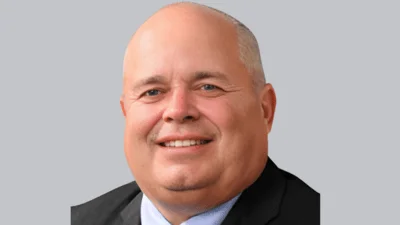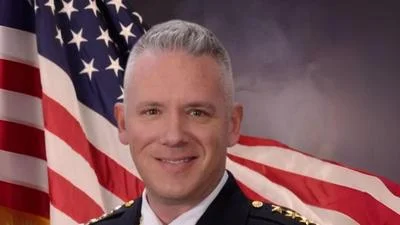OSF Saint Luke Medical Center recently issued the following announcement.
The health care industry faces an increasing number of challenges and is undergoing rapid changes as technology advances in unforeseen ways and the expectations of the population change along with it. OSF HealthCare Chief Executive Officer Bob Sehring has called for a shift in mindset for the entire organization. In keeping with the organization’s history of more than 140 years of innovation, Sehring charged OSF Mission Partners with being curious, critical, creative, quick and agile, and challenged leadership to embrace their roles as thought leaders, disrupting the traditional ways health care systems operate.
In this interview series, OSF HealthCare leaders sit down to answer four questions about how their teams are embracing innovation to build a healthy future for the organization and the communities it serves.
Jim Mormann has served as chief information officer for OSF HealthCare since 2010. In the last couple years he has also taken on the chief executive officer role for Integrated Solutions, which combines several back office functions under a collaborative umbrella, and for PointCore, Inc., an OSF HealthCare subsidiary that specializes in health care-specific construction. He probably manages to get some sleep occasionally, but that has not been proven.
1. Why is innovation important to what you and your team do?
It’s important to realize Integrated Solutions was formed by bringing together four or five of our back office type of services: supply chain, information technology, construction, biomedical services and real estate. They’re the services that don’t touch patient care, but we enable patient care.
Innovation really is about change. It’s about trying to create a new or different way of doing something. It’s this question of ‘What are we doing today about changing so that we’re prepared for tomorrow’s business?’ We can’t function the way we did four or five years ago.
Change is always happening, so we want to influence that change, rather than having change influence us. We’re more likely to embrace change if we make the decisions and choose the direction ourselves. We continuously ask ourselves ‘How do we retool our work today to prepare us for the business we’re trying to address today, not what we were trying to address five years ago?’
Change is always happening, so we want to influence that change, rather than having change influence us.CLICK TO TWEET
It’s an important part of everything we do. You can’t be in the information technology world and assume that change doesn’t occur. We seem to be on the tip of the spear all the time, trying to influence change into products that are coming out. The same is true of supply chain. The same is true of trying to get a greater consolidation of contract compliance. Change is inevitable and innovation is inevitable. We are constantly looking for ways to think about our practices differently, so we can retool them and prepare to deliver better service in the long run.
We have to think about different business models we may have been uncomfortable with in times past. For example, we may have to consider joint venture in some cases, because we may not be the foremost experts. We have to bring different partnerships to the table. We may ask to get out of certain business lines we thought we were once really experts at, but we’re not.
Innovation really is about retooling yourself to make sure you’re relevant in tomorrow’s world and making sure that we’re constantly pushing ourselves into that space. We’ve got to create a diversified revenue stream. We’re invested all in health care, so how do we begin to diversify our revenue portfolio to ease the bumps when cost issues arise?
I operate under a philosophy that talks about disrupting the disruptors. That’s a challenge, and we’re constantly looking at different ways to disrupt and recover services that have been disrupted. In places where we’ve seen movement away from us, how can we get that movement back in?
2. What is the biggest thing/change you see coming in health care within the next five years (that will impact your team’s work)?
The cost structure is going to be a big issue for all of health care. We’re watching consolidation of services, or consolidation of industry, continue to evolve. Why? Because cost structures continue to put pressure on us. Consumer demands are changing. We have people recognizing the cost of health care is getting out of control. But what can we control? That’s a big issue for us. So, cost is a big issue. Technology is a huge issue. Automation of activity is a big issue. Whether it’s imaging services or whether it’s in our direct patient care, the involvement of the types of technology and the data that we transmit today is pretty staggering.
We’re seeing innovation move product out of our facilities and into the cloud and other different forms we have to be more comfortable with. But at the same token, we’ve got to protect a little bit differently than what we’ve done. Naturally, the last 3-5 years have been really focused on cyber security threats, and they’ll continue to increase. I think it’s going to increase tenfold over the current level.
We’re seeing innovation move product out of our facilities and into the cloud and other different forms we have to be more comfortable with.CLICK TO TWEET
So, we’ve got a lot of challenges coming at us. We have an industry that most people will heavily scrutinize because we see that the cost of health care is still pretty staggering in the United States compared to elsewhere. So, how do we help reduce costs while also increasing our life span? I think that’s where we’re going to continue to challenge ourselves.
3. What are the big, forward-looking Integrated Solutions initiatives OSF HealthCare is tackling and what challenges do these initiatives face?
So, we took these disparate departments, stuck them together and said, ‘We need you to work differently. We need to figure out different ways of producing things at a lower cost. We need to do it with standardized practices. We need to give a common look and feel to the industry so people who interact with us have a positive experience. We need to create a disruptive economic picture.’
Allowing us to generate revenue from back office services – that hasn’t been done before. So, the energy we put into that space is pretty large. For the last two years we’ve been trying to cultivate all of those divisions together and create a single common intake, but we also started to launch several different services.
We don’t want to lose track of our core, right? We’re a health care company. We need to still continue to take care of the patient. The question becomes, are we doing it the best with the best use of our resources, or can somebody else actually do it better that’s just 100 percent focused in that area?
We’re a health care company. We need to still continue to take care of the patient.CLICK TO TWEET
For example, in May we launched the PointCore, Inc. construction team, where our construction arm joined forces with Core Construction and created a brand new company dedicated to health care construction. That’s not thinking the same way, because most health care organizations aren’t thinking about starting up a construction firm, right? It really was thinking out of the box.
We’re also seeing supply chain take a different look and feel. In days past people would tell you that aggregation of volume is the most important thing, where we’ve realized contract compliance is just as important, as far as cost savings. So, that’s radically changing how our outside company for supply chain – our collaborative – works.
You’re seeing us move differently with biomed services, too. You’re going to see us try to figure out how we manage both imaging and mechanical biomed differently than what we’ve done.
Last year, we also launched a centralized distribution channel for all our medical and surgical supplies, and this winter we’ll be launching the pharmaceutical component of that, which lowers our operations cost, aggregates our volume and produces a better solution set. Then the question becomes, ‘How can we capitalize on those solutions outside of our own world? How can we take that same value proposition that we found for ourselves and bring it to others?’ You’re going to see a lot of back office services that we’re continuing to push and populate differently, and we believe that’s a pretty consistent trend that we’ll see in the next five years.
4. Does being a non-profit, faith-based health system change the equation compared to for-profit healthcare?
It’s a luxury in a lot of cases for us to be faith-based because we have the opportunity to connect with those we serve at a much greater emotional level than what you’ll find at a non-faith-based organization.
The challenges, however, are many. A for-profit system is all about doing the most efficient work that you can possibly do. It’s about maximizing profit and maximizing your value to the shareholder, that’s what it really comes down to. It forces those organizations to really think through every piece of their workflow process, and sometimes service quality can take a hit.
A lot of for-profits have a mission they might use as a tagline, but you’re probably not going to see them live it like we do at OSF HealthCare.CLICK TO TWEET
But if we’re not going after those same things, like efficiency and maximizing value, then shame on us, because then we’re not being good stewards of our resources. But it’s also important for us, especially as leadership, to constantly re-evaluate what we’re doing and try to improve services to achieve the best possible outcome for those we serve. That’s critical. So, we can have a harder time following certain sound business principles because it can lead to hard decisions, like perhaps having to take a service out of a community, or we may do some things that aren’t as efficient as we could be because of how it impacts the community.
We’re one of the largest employers in the state. We’re usually the first or second largest employer in any community we serve. What happens to that community if we’re not there? What happens when services are no longer provided in that community?
Plus, Mission is big for us. A lot of for-profits have a mission they might use as a tagline, but you’re probably not going to see them live it like we do at OSF HealthCare
Original source can be found here.






 Alerts Sign-up
Alerts Sign-up